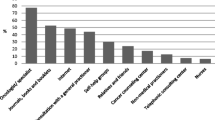Abstract
This study describes how melanoma patients used the Internet as a melanoma information source and how it impacted their clinical encounter and treatment decision. From 2010 to 2013, melanoma patients were invited to complete a 23-question paper survey with open- and close-ended questions. Thirty-one of the 62 patients approached completed the survey. The majority (90 %) of respondents used the Internet as a melanoma information source. Most (90 %) had used the search engine Google. The most commonly searched topics were melanoma treatment (96 %), screening (64 %), and prevention (64 %). While most respondents (85 %) found the Internet was a useful melanoma information source, over half (54 %) found melanoma websites at least somewhat difficult to understand. Many (78 %) believed it increased their understanding of their diagnosis, 71 % thought it influenced their treatment decision, and 59 % felt it impacted their specialist consultation. This study informs health care professionals that many melanoma patients search the Internet for information regarding their diagnosis and that it may impact their disease understanding and treatment decisions.
Similar content being viewed by others
References
York N, August NY, Poll H (2010) “Cyberchondriacs” on the rise? Those who go online for healthcare information continues to increase. http://www.harrisinteractive.com/NewsRoom/HarrisPolls/tabid/447/mid/1508/articleId/448/ctl/ReadCustom%20Default/Default.aspx. Accessed 26 April 2014
Taylor H (2011) The Growing Influence and Use Of Health Care Information Obtained Online. http://www.harrisinteractive.com/NewsRoom/HarrisPolls/tabid/447/ctl/ReadCustom Default/mid/1508/ArticleId/863/Default.aspx. Accessed 26 April 2014
Huang GJ, Penson DF (2008) Internet health resources and the cancer patient. Cancer Investig 26:202–207
Hesse B, Nelson D, Kreps G et al. (2005) Trust and sources of health information: the impact of the internet and its implications for health care providers: findings from the First Health Information National Trends Survey. Arch Intern Med 165:2618–2624
Berland GK, Elliot MN, Morales LS et al. (2001) Health information on the internet: accessibility, quality, and readability in English and Spanish. JAMA 285:2612–2621
Eysenbach G (2003) The impact of the Internet on cancer outcomes. CA Cancer J Clin 53:356–571
Institute. NC. SEER Stat Fact Sheets: melanoma of the skin. In: Surveillance, Epidemiol. End Results. http://seer.cancer.gov/statfacts/html/melan.html. Accessed 26 April 2014
Society CC (2014) Melanoma statistics—Canadian Cancer Society. In: Can. Cancer Soc. Advis. Comm. Cancer Stat. http://www.cancer.ca/en/cancer-information/cancer-type/skin-melanoma/statistics/?region=on. Accessed 7 June 2014
Bichakjian CK, Schwartz JL, Wang TS et al. (2002) Melanoma information on the Internet: often incomplete—a public health opportunity? J Clin Oncol 20:134–141
Sabel MS, Strecher VJ, Schwartz JL et al. (2005) Patterns of Internet use and impact on patients with melanoma. J Am Acad Dermatol 52:779–785
Harris I (2003) What does “The discovery of grounded theory” have to say to medical education? Adv Health Sci Educ 8:49–61
MTM (2013) Communications Monitoring Report 2013: broadband availability and adoption of digital technologies. In: Can. Radio-television Telecommun. Comm. http://www.crtc.gc.ca/eng/publications/reports/policymonitoring/2013/cmr6.htm. Accessed 27 April 2014
Nguyen SKA, Ingledew P-A (2013) Tangled in the breast cancer web: an evaluation of the usage of web-based information resources by breast cancer patients. J Cancer Educ 28:662–668
Quinn EM, Corrigan M, McHugh SM et al. (2012) Breast cancer information on the internet: analysis of accessibility and accuracy. Breast 21:514–517
Beaton C, Codd RJ, Holland P, Gateley CA (2008) Evaluation of the quality and accuracy of information regarding aromatase inhibitors available on the internet. Breast J 14:366–368
Eysenbach G, Powell J, Kuss O, Sa E-R (2002) Empirical studies assessing the quality of health information for consumers on the world wide web: a systematic review. JAMA 287:2691–2700
Meric F, Bernstam EV, Mirza NQ et al. (2002) Breast cancer on the world wide web: cross sectional survey of quality of information and popularity of websites. BMJ 324:577–581
Killeen S, Hennessey A, El Hassan Y et al. (2011) Gastric cancer-related information on the Internet: incomplete, poorly accessible, and overly commercial. Am J Surg 201:171–178
Grewal P, Alagaratnam S (2013) The quality and readability of colorectal cancer information on the internet. IJSU 11:410–413
Ademiluyi G, Rees CE, Sheard CE (2003) Evaluating the reliability and validity of three tools to assess the quality of health information on the Internet. Patient Educ Couns 50:151–155
Charnock D, Shepperd S, Needham G, Gann R (1999) DISCERN: an instrument for judging the quality of written consumer health information on treatment choices. J Epidemiol Community Health 53:105–111
Eysenbach G, Köhler C (2002) How do consumers search for and appraise health information on the world wide web? Qualitative study using focus groups, usability tests, and in-depth interviews. BMJ 324:573–577
Scali E, Ingledew P (2011) Melanoma patient information: assessment of the quality of internet-based information resources [abstract]. J Investig Med 59:183–184
Chen X, Siu LL (2001) Impact of the media and the internet on oncology: survey of cancer patients and oncologists in Canada. J Clin Oncol 19:4291–4297
Gimotty P, Botbyl J, Soong S-J, Guerry D (2005) A population-based validation of the American Joint Committee on Cancer melanoma staging system. J Clin Oncol 23:8065–8075
Canadian Cancer Society (2014) Canadian Cancer Statistics 2014. Special Topic: Skin Cancers. In: Can. Cancer Soc. http://www.cancer.ca/en/cancer-information/cancer-101/canadian-cancer-statistics-publication. Accessed 7 June 2014
Gorantla VC, Kirkwood JM (2014) State of melanoma. Hematol Clin NA 28:415–435
Conflicts of Interest
None
Author information
Authors and Affiliations
Corresponding author
Rights and permissions
About this article
Cite this article
Hamilton, S.N., Scali, E.P., Yu, I. et al. Sifting Through It All: Characterizing Melanoma Patients’ Utilization of the Internet as an Information Source. J Canc Educ 30, 580–584 (2015). https://doi.org/10.1007/s13187-014-0711-1
Published:
Issue Date:
DOI: https://doi.org/10.1007/s13187-014-0711-1




